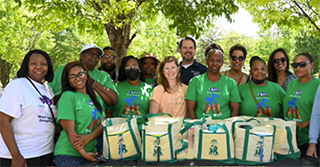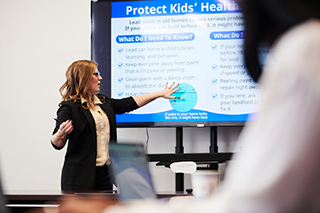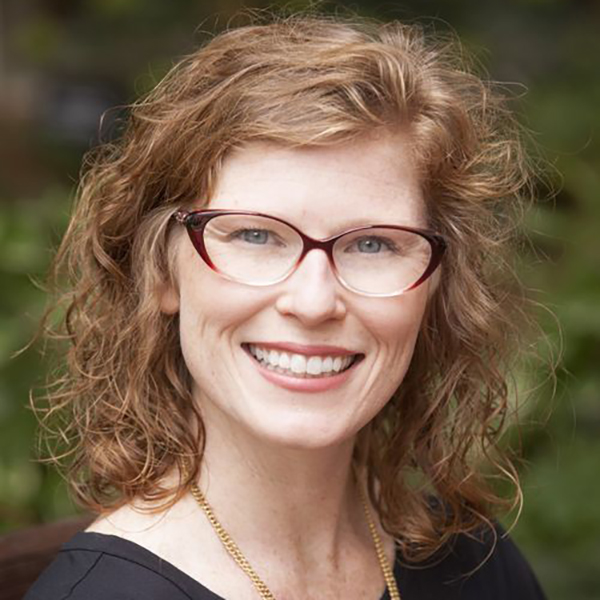In this highlight, we speak with Abby Mutic, Ph.D., M.S.N., C.N.M., and Nathan Mutic, M.S., M.A.T., M.Ed., both at Emory University, about their shared commitment to ensuring that research is communicated effectively so that people can make informed decisions.
“Over the years, we have featured individuals and their contributions to environmental public health. It is not often that we get to spotlight a family working together to advance this field,” said NIEHS Health Specialist Liam O’Fallon, M.A.
After meeting during graduate school at Vanderbilt University, Abby and Nathan married and began careers in healthcare and education — Abby as a nurse midwife and Nathan as a high school biology and chemistry teacher. While caring for patients, Abby became interested in how the environment affects pregnancy and health outcomes for mothers and their children.
“Many of the women coming to the clinic worked in farming or factories and had concerns about their exposures and whether those exposures were safe for their pregnancies, their health, and their families’ health,” Abby said. “I became really interested in answering those questions.”
Collaborating in the Field

“Synthesizing environmental health literature in a systematic and clear way is challenging work, but is so important for the general public,” Abby said. (Photo courtesy of Emory University)
When Abby started at Emory, she continued supporting farm workers, joining the Girasoles Research Program. The program, led by Linda McCauley, Ph.D., R.N., focuses on occupational and environmental health concerns of Florida farm workers, a group with an increased risk for heat-related illnesses.
“As nurse researchers leading the Girasoles study, we were able to connect biometrics, like blood sugar and kidney function, with how workers felt as temperatures change through the day,” said Abby. “We broke down complex information into clear terms, making it easier for research participants to understand the health impacts.”
During summer break from the teaching year, Nathan joined Abby in the field in Florida to help with data collection. Together, they developed a protocol to help researchers share health data with participants. It was during this trip that he discovered a new interest in environmental health.
“My teaching background prepared me to quickly evaluate where someone’s knowledge is and how to build on that knowledge to share information,” said Nathan.
Harnessing Social Media

“The support of the EPA and NIEHS was invaluable for providing an opportunity to exchange ideas,” Nathan said. (Photo courtesy Emory University)
Nathan shifted from teaching to supporting the Southeast Pediatric Environmental Health Specialty Unit (PEHSU) and the Emory Children’s Environmental Health Center (CEHC). There, he became passionate about clear scientific communication among scientists, clinicians, and communities tackling children’s environmental health.
After a meeting between the PEHSU and CEHC networks, Nathan and collaborators at the University of Illinois Urbana-Champaign and the University of Southern California launched a national social media campaign about children’s environmental health with funding from an NIEHS administrative supplement. The campaign, which built on findings from the 2017 NIEHS/EPA Children’s Environmental Health and Disease Prevention Research Centers Impact Report, allowed organizations in the PEHSU and CEHC networks to tailor posts for their own audience.
“The campaign was only possible because of the collaboration and leadership from each center,” said Nathan.
Nathan found that shared goals and authentic relationships with community groups — like translating environmental health research findings into practical information for reducing exposures to smoke, allergens, and other pollutants — lay the groundwork for effective engagement. While no longer at the PEHSU, Nathan carries those values into his current role as the Assistant Dean of Research Operations at the Nell Hodgson Woodruff School of Nursing at Emory University.
Advancing environmental health communication

Abby and Nathan Mutic (center) with partners from the Center for Black Women’s Wellness at a community outreach event. (Photo courtesy of Abby Mutic)
Abby now serves as the director of the Southeast PEHSU and is a professor at the Nell Hodgson Woodruff School of Nursing at Emory University. She collaborates with experts in nursing, toxicology, education, and other fields to turn complex environmental health data into clear, actionable information that directly benefits communities.
Like Nathan, Abby centers her work around community voices.
“It’s really important that my research is relevant to what folks in the community are most concerned about with their kids and their pregnancies,” she said.
Abby also collaborates with Sun Joo Grace Ahn, Ph.D., of the University of Georgia, on a virtual immersive experience that simulates asthma triggers in a home setting, helping participants understand how to improve indoor air quality. The project is supported by the NIEHS-funded Center for Children’s Health Assessment, Research, Translation and Combating Environmental Racism (CHARTER), which is directed by Linda McCauley, Ph.D., R.N.
“Talking about environmental health can feel overwhelming if people think they can’t change their environment,” said Abby. “Our simulation empowers people to reduce their air pollution exposure.”
In another study, funded by the National Heart, Lung, and Blood Institute and CHARTER, Abby works with early learning centers in the Atlanta area to measure indoor air exposure using silicone wrist bands worn by pre-K students. Her goal is to study how these pollutants affect children and if they can communicate respiratory symptoms to their parents.

Abby Mutic presents on the risk of lead paint exposure to community partners. (Photo courtesy of Abby Mutic)
“Building strong relationships with teachers was key to ensuring student learning and play was not interrupted by the study procedures and to build trust with caregivers,” Abby said.
Although they no longer work side by side, Abby and Nathan continue to support each other’s contributions to communicating environmental health to researchers and communities alike.
“I’m thrilled to see growing attention on translating environmental health research for communities,” Abby said. “Identifying how to effectively communicate this data is a science in itself, and communities benefit when we make environmental health information clear and meaningful.”



